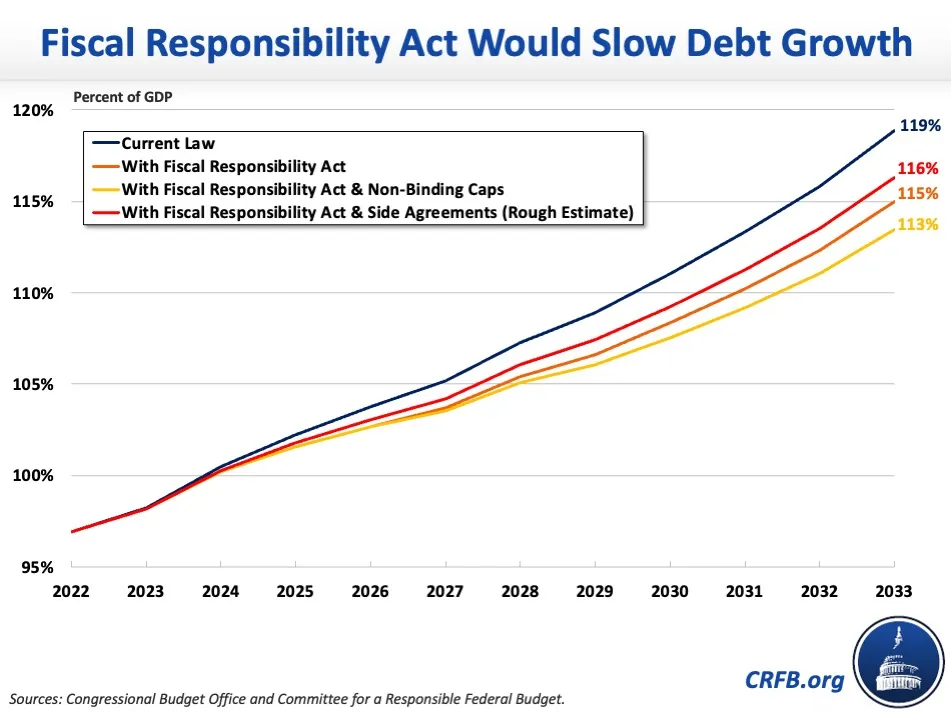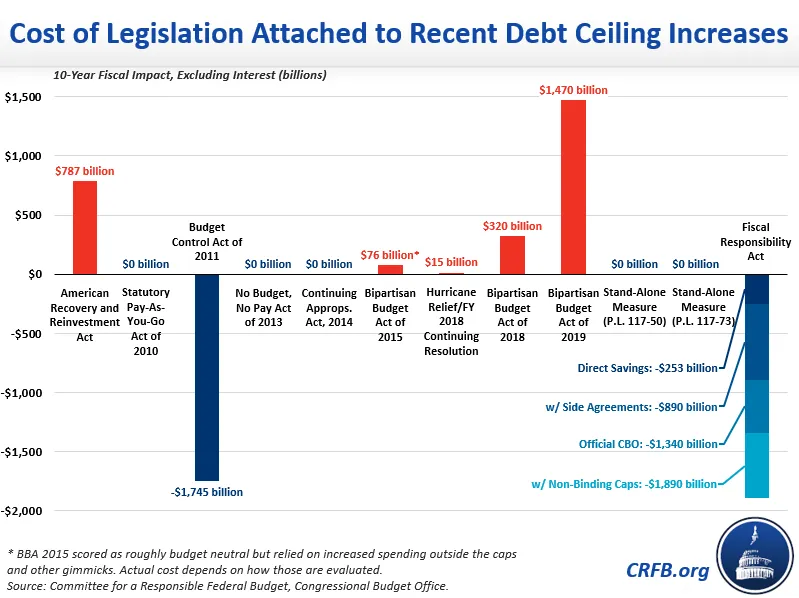How Much Would the Fiscal Responsibility Act Save?
The House-passed Fiscal Responsibility Act of 2023 (FRA) would suspend the debt limit and meaningfully reduce budget deficits – but by how much depends on the number of assumptions.
The FRA would produce roughly $250 billion of direct savings, mainly through establishing caps on defense and nondefense discretionary spending for Fiscal Years (FY) 2024 and 2025 and other policies; as a result, the Congressional Budget Office (CBO) estimates the plan would reduce deficits by $1.5 trillion over the next decade relative to its baseline. The deficit reduction in the bill could grow to as high as $2.1 trillion if policymakers adhere to out-year (FY 2026 to FY 2029) appropriations targets in the bill. On the other hand, we estimate savings would fall to roughly $1 trillion if appropriators adopt various adjustments agreed to through 'side deals' outside of the FRA.
Besides suspending the debt limit through January 1, 2025, the most significant element of the Fiscal Responsibility Act is that it would impose caps on defense and nondefense discretionary spending in FY 2024 and FY 2025, which would be enforced through sequestration. Appropriations have grown by 17 percent since FY 2021 – when the prior caps ended – and by 37 percent since FY 2017. This is much faster than the rate of inflation, despite the fact that spending on wars in Iraq and Afghanistan has all but ended (and Ukraine funding is not counted toward these levels). The Fiscal Responsibility Act would restore budget discipline to the appropriations process.
The FRA would cap FY 2024 base discretionary funding at $1,590 billion, with base defense spending capped at $886 billion and base nondefense spending capped at $704 billion. This would represent a 3 percent boost to defense spending, relative to its FY 2023 level, and as much as a 9 percent reduction in nondefense spending (depending on how it is measured). The FRA would allow defense and nondefense spending to grow 1 percent in FY 2025, with total discretionary spending reaching $1,606 billion in that year. A number of adjustments and side agreements (discussed below) would change these numbers, allowing appropriators to set ordinary nondefense spending close to the FY 2023 level in FY 2024.
The two-year spending caps in the Fiscal Responsibility Act would generate $245 billion of direct savings over ten years. Under long-standing scoring conventions, discretionary spending is assumed to grow with inflation after that – since appropriators generally set annual spending levels based mainly on the prior year. Including this extrapolation, CBO estimates these new caps would save $1.3 trillion over ten years.
What's in the Fiscal Responsibility Act?
| Policy | Official CBO Score | With Non-Binding Caps | With Side Agreements* |
|---|---|---|---|
| Cap discretionary appropriations in FY 2024 and FY 2025 | $245 billion | $245 billion | $160 billion |
| Baseline savings from lower appropriations in FY 2026 to FY 2029 | $560 billion | $785 billion | $400 billion |
| Baseline savings from lower appropriations in future years | $525 billion | $855 billion | $340 billion |
| Rescind unobligated COVID relief funds | $11 billion | $11 billion | $11 billion |
| Rescind increased IRS funding | -$1 billion | -$1 billion | -$20 billion |
| Reform work requirements in TANF and SNAP | -$2 billion | -$2 billion | -$2 billion |
| Total Policy Savings | $1.3 trillion | $1.9 trillion | $890 billion |
| Interest | $188 billion | $240 billion | $120 billion |
| Total Savings | $1.5 trillion | $2.1 trillion | $1.0 trillion |
Sources: Bill Text, Congressional Budget Office, and Committee for a Responsible Federal Budget estimates. Numbers may not sum due to rounding. *Estimates are rough, uncertain, and subject to change.
While the statutory discretionary caps in the bill expire after two years, the Fiscal Responsibility Act presents spending levels for FY 2026 through FY 2029 for purposes of congressional budget resolution enforcement, limiting discretionary spending growth to 1 percent per year. If adhered to, these targets would produce an additional $785 billion of direct savings and $855 billion of indirect savings. Under this scenario, baseline discretionary spending would be about $1.9 trillion lower over ten years than under current law.
Besides the discretionary spending changes, the Fiscal Responsibility Act would also claw back over $27 billion of unobligated COVID relief funds to 87 budget accounts, saving $11 billion over a decade; rescind $1.4 billion of the $80 billion of increased IRS funding for enforcement, at a cost of $900 million (due to revenue losses); and reform work requirements for Temporary Assistance for Needy Families (TANF) and the Supplemental Nutrition Assistance Program (SNAP) – including by expanding SNAP work requirements to those aged 50 to 54 but loosening them for veterans and the homeless – at a cost of $2.1 billion over ten years.
Taken together, CBO estimates the legislation would reduce projected debt by $1.5 trillion, or 4 percentage points of Gross Domestic Product (GDP), by FY 2033. Assuming the non-binding appropriations targets are met, the plan would reduce debt by $2.1 trillion, or 6 percentage points of GDP.
Importantly, CBO's official $1.5 trillion score overstates the deficit reduction it is likely to generate due to a series of reported side agreements meant to make it easier for appropriators to adhere to the caps. For example, the Fiscal Responsibility Act effectively puts $22 billion (paid for with other savings) into a Department of Commerce reserve fund that can be rescinded to cover future appropriations. The parties have also apparently agreed to cut $20 billion of IRS funding from the Inflation Reduction Act – designed to boost tax enforcement – in order to pay for some additional appropriations. In total, these and other adjustments would allow appropriators to keep ordinary non-defense spending at about 2023 nominal levels.
Compared to current spending practices, we believe these adjustments would reverse over $40 billion per year of the FRA's savings. Although we are unable to determine the exact effects of these side agreements and adjustments at this time, our rough estimate suggests the plan would reduce debt by about $1 trillion – about 2.5 percentage points of GDP – once they are accounted for.

Regardless of how one measures the FRA's savings, it would be the largest deficit reduction bill in nearly a dozen years. Under the most generous savings estimate, the FRA would be similar in size to the 2011 Budget Control Act (BCA) – a bit larger nominally but smaller after accounting for inflation or output growth (estimates below exclude interest savings for comparability). Importantly, the FRA would also reverse the recent trend in the late 2010s of coupling debt limit increases with legislation that adds to the deficit.

The Fiscal Responsibility Act also includes a number of important reforms that will prevent further increases in the deficit.
For example, the bill codifies the end of the student debt repayment pause, which has been in effect since March of 2020, by the end of August. If the Administration were to continue this pause, it would add roughly $5 billion per month to the deficit and would be costly, regressive, and inflationary.
The FRA also re-instates Administrative PAYGO, requiring new regulations to be paid for in most circumstances and establishing a new set of reporting and transparency requirements.
The bill also includes some modest permitting reforms that would speed up energy projects, including allowing for the designation of a lead federal agency as part of the environmental review process for major energy-related projects, and establishes an expedited review process for the Mountain Valley Pipeline. Both parties have apparently agreed to pursue further permitting reform later in the year.
The Fiscal Responsibility Act would represent the largest deficit reduction package in almost 12 years, generating $250 billion to $2.1 trillion of savings while helping to fight inflation, promote stronger economic growth, and ensure the country continues to pay its bills. While far more work is left to be done, it represents a significant step in the right direction.


